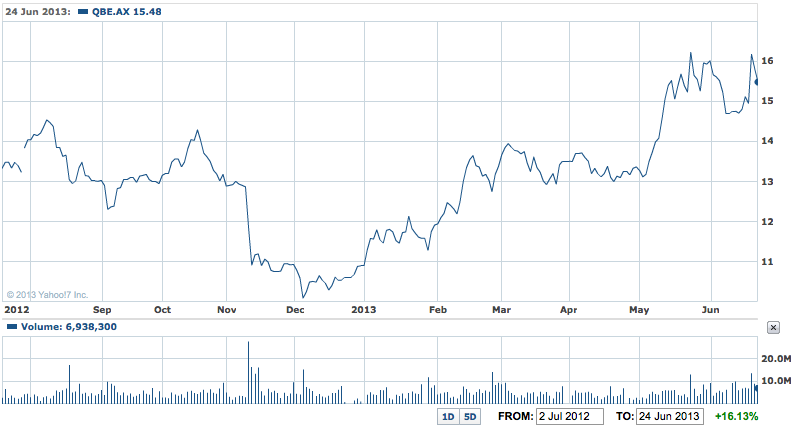QBE says it is on track to meet its full-year guidance as it benefits from relatively few natural disasters, the recent fall in the Aussie dollar and lower reinsurance costs in some markets, such as the US.
QBE told the ASX in an operational update that it is also on track to hit its target to cut costs by "at least" $US250 million by 2015, as it replaces hundreds of jobs in western countries with staff in Manila.
The news saw its shares rise by 64c or 4.2%, to $15.94 yesterday.
QBE 1Y – QBE shares lift on cost cuts

QBE release updated the market on progress under its $US250 million a year savings plan (by 2015) earlier this year, with a key part the moving of about 700 positions from its worldwide operations to the Philippines.
The company’s CEO John Neal told analysts yesterday that the company was now looking for savings of "at least" $US250 million based on changes to its Australian operations alone where the original target was $A85 million, but could now be more.
The cost-cutting push will also result in changes to its operations in North America, and QBE may look to start cutting in its European business earlier than expected. "This is very much the start, the first wave if you like, and there will be more activity that will follow," Mr Neal said in a tele conference yesterday.
So far, 521 positions in Australia have been affected by the offshoring changes, most of these have been redeployed, 39 have been made redundant and 52 contractor positions have not been renewed (making 89 job losses in all).
Mr Neal also said he was confident the company expected to hit its full-year forecast for premiums to increase by about 5% and the company has benefitted from several one-off factors.
He said conditions were "very positive" in Australia and North America but tougher in Europe, where rates were flat.
"It’s still very very early days in the year but we are quite relaxed about where we see ourselves for the half year." (This will be unveiled in August.)
QBE said in its presentation that it and other insurers have had the benefit of relatively few natural disasters in recent months (except for storms and tornadoes in the US and flooding in parts of Europe, especially Germany). QBE has extensive US operations, so it tends to benefit from a falling Australian dollar. But QBE reports in US dollars, so the advantage is not all that big. In fact the company will also feel the negative effects on translation from the Aussie dollar and the UK pound into US dollars.
"Overall, the weakening in the Australian dollar is good news for us, but it does bring some complications," Mr Neal said. The company did point out the major risks in the US especially are in the current (second half) with the hurricane season and the northern winter approaching.
A large number of insurers settled reinsurance contracts as of last Sunday and industry reports suggest that there will be small falls of up to 10% for some lines of insurance in Australia, and up to 25% in the US because of the surge of investment money flooding into the reinsurance market from hedge funds, private equity, investment banks and pension funds looking for returns higher than US bond rates.
This has led to a sharp increase in capacity in the US reinsurance markets (which always leads to rate cutting and lower premiums and better priced deals on offer from reinsurers). Capacity has risen in other markets such as Australia, the UK, Europe and Asia, but not by anywhere near the rise in the US.













